|
|
|
Tour in the East of the Island Gran Canaria
As the airport of Gran Canaria is located at the east of the island, one also gets his first impressions in this region. By leaving the street sections of the the airport that are planted with flower beds, one is first disillused. The fist picture that is presented to one is that of a scant rocky landscape in direction to the centre of the island and rather not aesthetical buildings of each of the small places on the way to the holiday residence in the south. It is hard to believe that Gran Canaria has some green and brightly overgrown areas. Therefore, one had to drive in north-west direction. Here at the east coast there is barely anything what makes the heart of a tourist beat faster. Neither nice bathing bays, nor really attractive small cities. Those who come by car will enjoy the rapid connection of the three-tracked motorway that communicated the north and the south through the east side. 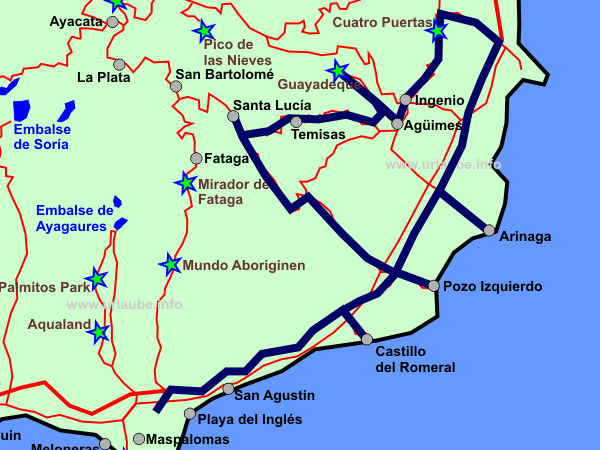
But during our tour through the east we still could discover some sides of Gran Canaria that impressively stayed in our minds. Thus, the surfers for example, who almost always make use of the blowing wind at Pozo Izqierdo in breadneck manner. Or the wonderfull canyon Barranco de Guayadeque, that nearly reminded us of American canyons. We started the first side-trips of our exploration of Gran Canaria alongside the coast in the southeast. Castillo del Romeral is a small sleepy place nearly without any tourists that would probably awake the interest of some ultra-individualists. Pozo de Izqierdo to the contrary, already has a confirmed fan club amongst the surfers. Amongst the surf professionals, this place is known for its gurantee of wind and weather and, impressively, it is even the place where the surf-weltcups take place. Arinaga expands from the motorway up to the coast, over three areas. If one does not get deterred by the industrial areas on the way to the centre, one can have a sunbath on the beach. As according to the travel guide there were two further highlights at the north of Ingenio und Agüimes we wanted to visit, we decided to have a small detour that can be easily done without losing much time by taking the motorway and the GC 140. Cuatro Puertas is one of the cultic cave complexes between Telde and Ingenio, from which one has a fantastic view to the east coast in direction to the airport and the Museo da las Piedras is a side trip worthwhile if being on the way to Ingenio. 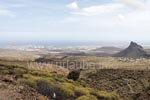
In Agüimes, a sideway leads to the Barranco de Guayadeque, an excellent canyon for which a side trip would already be worthwhile for. The street within the canyon ends at a restaurant, so that we had the opportunity to eat something before getting back in order to continue driving shortly before Agüimes on the GC 500 in direction to Temisas, a small place between Santa Lucia and Agüimes where it is possible to view some caves in case one finds them at all due to the sparse signpostings. From Temisas it is not far to Santa Lucia, a really beautiful place with palms and colourful flower beds. Here, the museum lovers will find in the m Museo Castillo de la Fortaleza findings of the pre-spanish inhabitants of Gran Canaria and can at the same time have a rusty meal in the appending restaurant Hao. On the GC65 be return back from Santa Lucia in direction to the coast and the motorway. Castillo del Romeral: Sleepy small place at the coastCastillo del Romeral is a very small coastal place where we did not see one single vacationer in the year 2008. One hardly has the impression of being in a touristical region as its bathing resorts are also far away located into the south. Here, the fishermen are standing in front of the mole, fish some fresh fishes and the atmosphere had something sleepy. 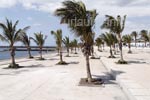
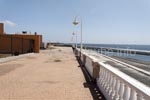
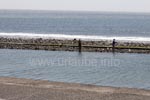
Although it is hard to imagine that the village has a well working infrastructure, there are still some fish restaurants. One will surely be attracted to this place when one for example is fed up of the hustle and bustle of Playa del Ingles and wants to walk alongside a promenade where there are no tourists at all. The arranged beach promenade appears to be very new and the beautifications are quite recent. One can only speculate about the development of this place in the coming years. Pozo de Izquierdo: The Surfer-Mecca of Gran CanariaThe fact that in the east at the area of Pozo de Izquierdo the wind blows is specially noticeable in the many wind mills stationed here for the production of electricity. The abundant wind mills are already visible from a distance, even by approaching the island by plane. But as here is not simply wind but optimal wind conditions, one knows this latest when one is there and sees the many surfers. In this area around Pozo de Izquierdo, even world cup competitions of wind surfing take place on a regular basis. 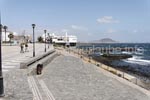
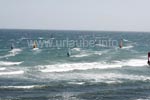
This place is nothing for beginners or such who also need a nice view beside the wind. In this place, apparently only professionals feel good, as this place hardly has anything to offer. Here, the area appears to be rather barren and the way up to this surfer section leads through a narrow road away from the motorway where one hardly sees anything beside the wind and some torn up tarps. Nevertheless, it is allowed to take part to this rude atmosphere and it is also possible to get there something to eat; We certainly also saw a signpost indicating to a beach section for bathing, but we continued driving as visiting the beach with such a strong wind is nothing pleasant. ArinagaArinaga is a relatively big place that extends over three areas; At both sides of the motorway, both rather ugly looking industrial areas are located with some huge furniture shops and shopping giants similar to factories. One should not get immediately deterred by these two industrial areas. By continuing the road further in direction to the coast, one comes out at a nicely arranged promenade. 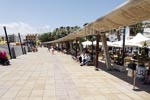
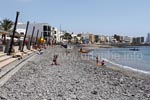
The beach section certainly appears to be very calm but those who want to bath here apart from the masses hace to accept this stony bay. Therefore, the beach area goes very shallowly into the water, a thing that is very pleasant for families with little children. Those who like can spread the towel on the stairs right at the adjacent boardwalk. Despite of the relatively few tourists, here is a vivid fishing business. The boats come in and out on a regular basis and the mole offers a nice panorama and the restaurants' terraces are completely crowded. Cuatro Puertas: Cult Place with a fantastic ViewCuatro Puertas is a cult place at the country road between Telde and Ingenio. It is a small mountain hill that can be easily walked up. For an excursion to Cuatro Puertas one should plan about one hour. 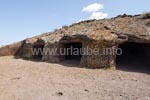
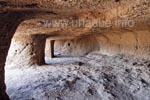
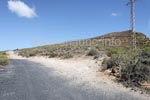
The view from this 320 metres heighted hill is very impressive. Already on the way to there one can already see four arched gates that are the entrace to a relatively big cave. But before getting to there, the best is to park the car at a provisional parking place, as the narrow path up the further hill is covered with some deep holes and some thick stones make the drive with a normal car impossible. 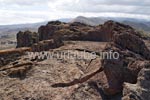
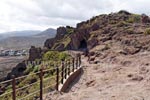
We also changed our sandals for some sneakers, as without them we would not have been able to move safely upwards the complex. After about 10 minutes one stands in front of the "4 entrances". We tried to decode the further way described on a small board. Due to the natural conditions the paths are hardly to be clearly determined. We slowly moved forwards by using the small red-white pillars as an indicator. But in the upper part of the mountain one should be definetely sure-footed, as we also had to make some small jumps. In the further area around Cuatro Puertas one can still discover a cult place and two further cult caves. Even though the real meaning of this place remained a mistery to us, during the side trip to this mountain one enjoys a great view to the eastern coast. Beside the suspicion that this üplace has been used for cultic purposes, another theory says that the geometrical wall and ground signs were related to some astronomic observations. Both things can be surely considered. We really liked the hiking tour to the mountain hill. Cuatro Puertas is a place that is specially avoided by most of the tourists. Thus, one is normally alone here and can enjoy the view unhurriedly. Museo de las Piedras: Tourist Souvenis in AbundanceBy looking at the huge parking place in front of the museum, one rapidly believes the information stated in the travel guides and well imagine how the tourists rush to this place in buses. Not because the tourists want to know something about the history of Gran Canaria but because they want to purchase all kinds of souvernirs. 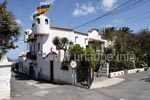
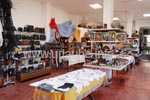
The Museo de las Piedras is actually not a real museum but a collection of numerous exhibits that can be purchased. here, there are souvenirs en massee. Some items are certainly part of the decoration and antique as for example old typing machines, pots and irons, nevertheless, the business is focused on hand made table ware or items for the daily life made of clay or wood as for example some ashtrays or wall plates. Also bags, belts, or other clothes can be purchased. The entrance is free and browsing there was fun probably due to the reason that we did not have the impression to be obliged to buy here something. DThe ladies who were selling the staff and/or those ladies who seemed to manufacture these things apeeared to be friendly and reserved. 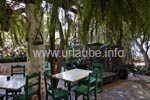
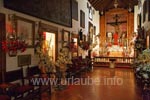
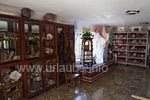
Certainly a little kitshy, but still very amusing: the room full of altar and church items. All there Maria-, Jesus- and holy figurines did not match at all to all the table ware and ashtrays of the other rooms. But maybe just these bizarr contrasts were what this museum gave its charm; Even though we are not fans of such kitshy consumption worlds, this short side trip still had something interesting. The samll garden in the inner yard was very nice where one could relax there in a shady green place. Here, one could have a drink while listening to the birds chirping and while looking at a small goat and also visit the toilet again. From the exterior, one would never expect such an idyllic garden and yard complex thus we found this unexpected recuperation to be very pleasant. Ingenio: Centre of ArtworksThe embroideries already seen in the Museo de las Piedras are typical of the area of Ingenio, as Ingenio is described as the centre of the artworks. Not only labourious table ware is produced here but also the costumes decorated into the detail for the singers and dancers of folk music groups. 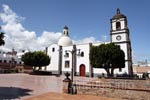
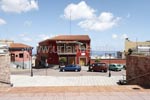
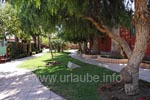
Those who shortly visit the centre of Ingenio will be pleasantly surprised. At least we were. Although the square right in front of the church seemed to be deserted, the facilities around it were arranged with a lot of love to the detail. Several fountains are surrounded by nice graan meadows and flower beds. The door to a small green park was also opened to a small play ground for children at the same time. From the forecourt of the church that seemed in total to be very open and generos without being covered by a lot of small streets and alleyways as it is the case in other places, even had a free view up to the sea. Here, it was very relaxing to get out of the car for a short while and have a small walk. There were also some public toilets right at the forecourt. Agüimes - Greeting from AfricaIt was not that easy to get to the centre of Agüimes. Due to the many one-way streets and the not really well concepted signposting, we had to park our car outside the alleyways. But as it resulted, it was not too bad, as by this way we were able to experience more of the labyrinthine small streets. 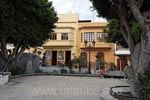
The arquitecture of the houses and the colour of their claddings that in the centre mainly were ochre and terracotta colours almost reminded on a oasis city of Africa. This impression was emphasized by the partly life-sized replications of camels positioned at the alleayways. 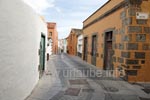
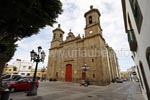
Due to the activities of the rural tourism that improves the tourism in the rural areas and by this way counteracts the continuosly increasing migration into cities, the characteristic of the old buildings are in the foreground; Normally, the Turismo rural is rather focused on rural areas, but here in Agüimes it is possible to stay over night in one of the restaurated oldtown houses. In the centre itself there is an impressive church. Today, the three-naved Basilica San Sebastian gets in addition to its brown stones a distinctive contrast by the red portals. The centre around the church is very nicely arranged. Bars, restaurants and souvenirshops all around the church square are surrounded by many palms and bushes. Due to the abundance of benchs that invite to relax under the shady tress, almost a park atmosphere arises. Barranco de Guayadeque: Relief of American CanyonsAt the north eastern city limit of Agüimes, the GC 103 leads straight to the Barranco de Guayadeque. The imposing canyon with its partly up to 400 metres steeply rising up rock faces really amazed us. Other canyons we crossed in Gran Canaria offered a much wider panorama as the canyons were much wider. As here, the hillsides at the left and at the right really seemed to be within our grasp, the canyon-effect remained much more impressively in our memories. 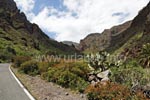
The routing was narrow in total and the sections between each of the stations, a museum providing information about the canyon and the cave village that still today is inhabitated were surprisingly short. This tour is probably so apt for families because because in short intervals it repeatedly offers the posibility to rest and at the end of the road not only a cozy but also a very good restaurant is waiting. Already a few minutes after we turned to the road to the Barranco de Guayadeque, at the left side, the Centro de Interpretacion Guayadeque appeared. it is really worthwhile to visit this small but very interestingly structured museum. Canyon Museum: Centro de Interpretacion GuayadequeThe porch of this museum remings on a common house but behind it, a cave opens that has been carved from the mountain according to the arquitecture the inhabitants used to have. Here, the word museum does not have a dusty or boring character but should in a very vivid way the development of how the canyon was originated and slowly inhabitated by the humans. One gets a picture of how the landscape was originated from the interplay of volcanic action and the erosion power and how the poeple could inhabitate the canyon and still make use of it today due to its water resources . 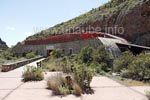
The canyon panorama is originated in such a spectacular way because the course of the water from the central area of the volcano caldera up to the beach has cut a deep score into the valley. The resulting relief presents itself in some spots as almost vertically standing walls. By this way, three different climates and altitudes result that extend from the peaks in the centre of the island to middle altitudes up to the even areas of the sea coast. 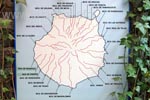
From the very beginning, the water supply weas an important criteria for the population. On one hand, the numerous water resources served as the main water supply and the agricultural watering of the fields, on the other hand, the sophisticated use of the water power for the operation of mills the use of grain could be futher developed. The food storage, specially the use of the caves for storing food can be retrospectly well followed by some arqueological findings. 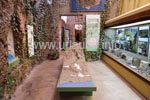
The structure of the museum is really well organized. One gets an overview of each of the canyons of Gran Canaria and the way the Barranco de Guayadeque is related to it. Mini replications about the course of the canyon show the relief of the canyon and one gets the feeling to understand the interrelations. Some film animation that can be started in several languages on a screen show some exciting documentations not only about the daily life but also of the cult of funeral. Specially mummies and big funeral caves belong to the spectacular archeological findings of the canyon and really amaze the visitors. Guayadeque and the Cuevas de Bermeja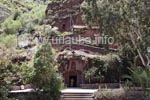
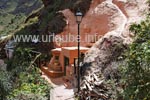
By continuing driving from the Museum Centro de Interpretacion Guayadeque into the canyon, one gets after a short stretch to the cave village Guayadeque that is freely accessible. By getting out of the can at the parking place in front of the cave village, one has the impression of a vivid ado only by listening to the soundscape. Dogs bark from a distance, chicken cackle, pigeons coo - but one does not really know where these sounds come from. At first sight, one recognizes a small church by its cross. All other "buildings" do not come out of the cave walls until having a close look to them. 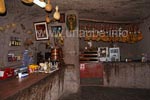
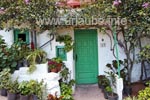
The Cuevas de Bermeja, the "scarlet-red caves" are first hardly visible alongside the hillside between the leafy walls. Not until one walked a few steps towards the cave houses, one recognizes how lovingly these small living domiciles are decorated with flowers and colours and that the are real inhabitants greeting one from the windows. Some steep stairs communicate each of the houses and small stables to each other. Those who want to have something to eat there will find two restaurants right beside the chhurch. one of them is rather a bar where numerous hams are hanging from the ceiling. It is ppossible to rest outside in the forecourt. The restaurant El Centro Guayadeque is a cave restaurant for the case one is much too hungry and cannot do it any more up to the cave restaurant Tagoror that is located further above. Cave Restaurant Tagoror: Highlight at the end of the CanyonUnfortunately, the street at the upper end of the canyon ends at some point, so that at the restaurant Tagoror one is obliged either to continue on foot, return or to make use of the restaurant in order to get a real cave feeling. 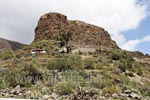
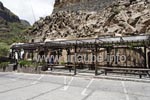
In fact, the restaurant was a small highlight. The interior of the restaurant subdivides into smaller cave areas where countless tables made of stone and wood offer enough seats even for swarms of tourists whereby there would be still anough space for everybody. Due to the reason there was enough personnel even in case of a big rush, there were no long waiting times. 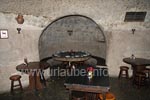
The food based onb the usual choice of Canarian specialities was not only very good but also very cheap. The interior was certainly pleasantly temperatured but for people who feel easily cold it is recommendable in any case to take a jumper or something similar as the benchs are made of stone. In total, we got a very dapper inmpression as the toilets were also in perfect condition, a thing we did not expect. Thus, although Tagoror is an excellent tourist restaurant where tourists come in buses to, we can confidentially recomend this restaurant. Temisas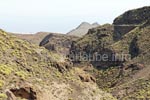
During the return from the Barranco Guayadeque we turn shortly before the end of the canyon to the left on a small road in direction to Temisas. The way to Temisas led us again through some spectacular canyons from which one has a wide view from above to the sea coast at the east. inside the palce, some narrow streets led alongside the hillsides. Unfortunately, we could not see any signpostings that led to the caves with wall paintings as described in the travel guide. Those who take mopre time and probably asks the local people maybe get more information about how to get there. For us it was enough to see the church San Miguel of the 18th century and to enjoy the further driving through this area that is under natural protection. Santa Lucía de Tirajana: leafy City amidst scant MountainsSanta Lucia belongs to those small cities that we keep in our memories in a pleasant way. After the scant coulisse to which our eyes nearly get used to until then, the drive to Santa Lucia offered a completely different picture to us. Countless bright green palms and colourful blossoms in widely arranged flower beds made us forget all scant rock faces. 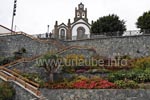
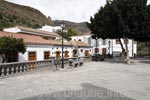
We found it very relaxing to be suddenly surrounded by many plants and flowers even though it does not seem to be in ecological relation to this dry area and the not existant water resources. But we noticed the difference how strange a scant and dry surrounding can appear. We get there a nice view down to the central square with the many benchs. Also the area around the church is nicely arranged with benchs. The trees on this dapper place provided some shade in between. The claddings of the small bright houses with the irregularly arranged stones perfectly framed the holiday coulisse; Amazingly, this beautiful place was almost deserted. Museo Castillo de la Fortaleza in Santa LuciaAfter we viewed the centre of Santa Lucia (see previous chapter), we went about one kilometre further by car up to the Museo Cstillo de la Fortaleza. this small museum cannot be missed. It is located right at the main road in Santa Lucia and really has the shape of an ancient castle. 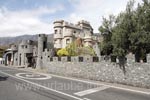
The parking place is a little hidden behind the castillo. This museum is privately owned and belongs to the same person who also owns the appending restaurant Hao. The passion of the owner is reflected in the whole complex. The loving delicate work is amazing. The extensive museum exhibits witness the life of the pre-spanish inhabitants. There ar eceramics, tools of findings for the agricultural use of whole Gran Canaria visibly arranged. The findings of mummies are repeatedely impressive and an exciting addition to the stones, plants or animals. 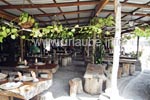
The Museo Castillo de la Fortaleza in Santa Lucia is worthwhile to visit specially also due to its cozy barbecue restaurant Hao. The smell is of charcoal and this made our mouths water. The portions we saw on the plates of our neighbours gave us certainty that here the food must be good. One sits on some wood stools in a semi opened area so that one gets enough fresh air. In the interior, the area of a bodega, where some wnes offered for selling are arranged at the wall and the souvenirs give a nice impression; The atmosphere got more friendly by the waiters that seemed to do their job purely for fun. Until now, we seldom experienced that. Thus, the barbecue restaurant Hao is a clear restaurant tip in Gran Canaria. La FortalezaOne only gets to Fortaleza de Ansite or also Fortaleza Grande, a rock rising up, by taking underneath Santa Lucia the GC-651 to La Surrueda. The partly naturally originated caves and the ones partly made by humans can be seen from the road. The small street drives further alongside the canyon of Tirajana that leads back to the civilization at the upper side of the smallplace Sardina. From here, it is not far anymore up to the motorway. Back to the index Gran Canaria Copyright: Patrick Wagner, www.tourist-guide.biz |
||
